EUROPARC Federation Seeks New Director to Lead European Conservation Network
The EUROPARC Federation is pleased to announce the recruitment process for its next Director. This is a rare and exciting opportunity for an experienced and visionary leader to steer Europe’s foremost network for Protected Areas through the next chapter of its development.
With hundreds of responsible authorities and thousands of Protected Areas in over 40 countries, the EUROPARC Federation plays a pivotal role in shaping policy, sharing best practice, and fostering cooperation to protect Europe’s unique natural and cultural heritage.
We are seeking a highly motivated individual with a strong background in nature conservation, environmental policy, and strategic leadership. The ideal candidate will bring passion, experience, and a deep commitment to the values that underpin the Federation’s work.
A Strategic and Influential Role
The EUROPARC Director will be responsible for:
- Providing strategic and operational leadership of the Federation
- Representing EUROPARC at European and international levels
- Leading and managing the staff team and day-to-day operations
- Coordinating the development and implementation of the Federation’s work programme and Strategy to 2030
- Strengthening relationships with member organisations, stakeholders, and European institutions
- Overseeing financial management, fundraising activities, and major events such as the annual EUROPARC Conference and General Assembly
This role requires a dynamic leader who is ready to champion the role of Protected Areas in addressing pressing environmental and societal challenges, from biodiversity loss to climate change adaptation.
Who Should Apply?
We welcome applications from individuals who can demonstrate:
- Proven leadership experience in an international or membership-based organisation
- Strong knowledge of European nature conservation and policy frameworks
- Excellent communication and advocacy skills, particularly in English (German and additional languages are advantageous)
- Experience in staff and financial management, and international project delivery
- The ability to build consensus and inspire collaboration across cultural boundaries
The post is based in Regensburg, Germany, and requires regular travel across Europe. A competitive remuneration package will be offered, and the successful candidate should ideally be available to start in September or October 2025.
How to Apply
Applicants must submit the following documents in English:
- Curriculum Vitae (CV)
- Motivation Letter, addressing the outlined requirements
- List of references relevant to the position
Applications should be sent by email to Michael Hošek, President of the EUROPARC Federation at: michael.hosek@integracons.com
Please use the subject line: EUROPARC Director Recruitment
Deadline for applications: 29 May 2025 at 14:00 CET
Full details about the role and requirements can be found in the Recruitment Pack.
Our Commitment to Inclusion
EUROPARC is committed to building a diverse and inclusive team. We encourage applications from individuals of all backgrounds, cultures, and experiences.
We look forward to welcoming a new leader to help us realise our vision: Sustainable Nature; Valued by People.
Read the full Recruitment PackFrom Consultation to Concrete Action for Young People and Climate Action
The process for a Council of Europe recommendation
Following extensive consultations with young people from across Europe, the Council of Europe has formalised its commitment to youth engagement in climate policies. Read how Protected Areas can commit to supporting young people and bringing policy to life in our parks!
The Council of Europe has adopted a new set of recommendations on “Young People and Climate Action”, marking a significant milestone in recognising the vital role of youth in addressing climate change.
From Consultation to Concrete Action
In March 2023, the Council of Europe launched a comprehensive consultation process aimed at understanding young people’s perspectives on climate crisis. As reported in our previous news article, this initiative was in part linked to the movement to incorporate climate justice into the Council of Europe which we see through the cases brought to the European Court of Human Rights and the discussions to incorporate the Human Right to a clean, healthy and sustainable environment.
The consultation engaged young people from diverse backgrounds, including EUROPARC’s Youth Officer, Jessica Micklem-Kolenić. It sought to understand how young people perceive the impacts of climate change on their rights, what actions they believe governments should take, and how they could be meaningfully involved in climate decision-making processes.
Key Recommendations
The newly adopted recommendations (CM/Rec(2024)6), reflect many of the concerns and suggestions during consultation phase. The document outlines several priority areas:

Fridays for future – global climate strike on the European elections in May 2019. By Markus Spiske.
Ensuring Young People’s Access to Rights
Protecting young people’s rights in a changing climate is essential including their rights to life, privacy, and property as guaranteed by the United Nations Convention on the Rights of the Child (UNCRC) and European Social Charter. Peaceful climate demonstrations must be permitted while removing barriers to civic engagement and ensuring access to environmental judicial reviews such as environmental impact assessments. Proper training for law enforcement on responding to youth gatherings is crucial to avoid excessive force. The members of courts require additional training on the climate science and youth climate activism methods to fairly evaluate cases that involve new climate science and unfamiliar protest tactics. Examples include:
- During arrest, legal support should be accessible for all
- Marginalised Indigenous and disadvantaged youth deserve heightened protection
- Recognition of the right to a clean, healthy and sustainable environment in local and European courts for present and future generations
Strengthening Youth Participation
Climate policy development should incorporate young people’s perspectives on crisis impacts, merging scientific evidence with firsthand experiences. Diverse youth participation in climate decision-making requires a supportive environment at all levels. Information on climate legislation must reach young people directly, with their viewpoints integrated into regulatory processes. Capacity building and financial support are vital for youth climate initiatives. The youth climate movement deserves autonomy to be free from interference, while any decision-making processes should eliminate social and gender barriers. Educational systems from early childhood through adulthood should foster ecological awareness and environmental commitment.
Protected Areas can and are contributing to strengthening youth participation. Not only with school visits and tours highlighting the linkages of nature and climate but also through non-formal education initiatives such as the Junior Ranger and Youth+ programmes. These work towards having local young people connected to their natural heritage, understanding the local context and empowered to speak up on behalf of Protected Areas. Some Protected Areas are even able to make micro funds available to their engaged youth, who redirect it into the local community for art and storytelling activities, key tools for reaching others to ignite a passion for sustainability and climate action.
Investing in Green Jobs, Education, and Skills
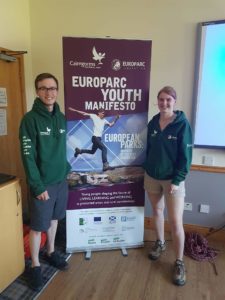
EUROPARC Youth Manifesto Project, 2018.
Education frameworks need adequate funding to equip young people with climate action knowledge and competencies for all career pathways, not just those wanting to go into green careers. Additionally, we need more just transition pathways that provide opportunities for young people to develop green skills. These could be accessible micro-funding schemes for young green entrepreneurs, increased research funding in green technology for young researchers, and funding mechanisms for youth organisations running climate projects, particularly those serving marginalised communities.
There have been significant improvements in creating youth accessible pathways into green careers in and around Protected Area. The EUROPARC Youth Manifesto was one tool, used by young people and Protected Areas to reduce the barriers for young people to live, learn and work in rural areas around the Protected Areas. Protected Areas are also creating learning spaces for volunteers, interns, apprenticeships and including measurements of equality, diversity and inclusion in self-reflections and recruiting processes.
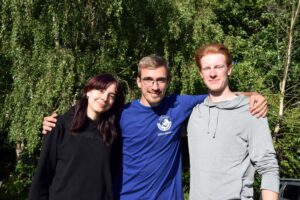
Three Junior Ranger mentors at the IJRC 2024 who were Junior Rangers themselves.
Investing in Tailored Support to Youth Workers
Youth workers play a fundamental role in mobilising environmental advocates and require proper sector funding. Resources for implementing youth-focused climate projects are essential, along with comprehensive training on climate topics for effective knowledge sharing. Multilingual, accessible resources help include all young people in climate action. Climate Advocacy benefits from peer learning exchanges across local to European levels.
The mentors of Junior Ranger and Youth+ programmes are often rangers and environmental education staff, but occasionally are also volunteers with diverse backgrounds. Protected Areas can ensure that these youth workers are sent to regular training or opportunities where they can exchange and learn from others such as at the International Junior Ranger Camp or EUROPARC’s e-Networking meetings. Similarly, the engaged young people and young professionals can be sent to events such as the EUROPARC Conference as a learning and networking experience at the international level.
Ensure Access to Healthcare and Targeted Youth Services
The impact of climate change on young people’s physical and mental health requires mitigation through targeted measures. Eco-anxiety and other climate-related health effects demand research to develop specialised services. Awareness campaigns should educate professionals, parents, and youth about eco-anxiety, with training provided to recognise symptoms. Specialised health services with properly trained providers are necessary for young people experiencing eco-anxiety, with youth involvement in the service design. Healthcare quality and accessibility for disadvantaged groups can improve through strategic investments.
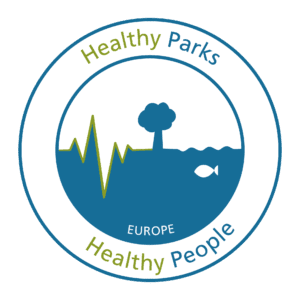 Protected Areas can join the Healthy Parks Healthy People Europe programme, and implement initiatives that tackle eco-anxiety by promoting the message that “nature is a good medicine”. An example of how is the promotion of the Five Ways to Wellbeing in Nature (5WWW), a set of evidence-based actions that promote good mental health and well-being. These five actions — Connect, Be Active, Take Notice, Keep Learning, and Give — are especially effective when practiced in nature, helping to alleviate eco-anxiety and improve overall mental well-being. Another tool is the use of green prescriptions, which encourage individuals to spend more time in nature and engage in outdoor activities to boost mental health. Green prescriptions leverage the therapeutic effects of nature to help people cope with mental health issues, including anxiety related to environmental problems.
Protected Areas can join the Healthy Parks Healthy People Europe programme, and implement initiatives that tackle eco-anxiety by promoting the message that “nature is a good medicine”. An example of how is the promotion of the Five Ways to Wellbeing in Nature (5WWW), a set of evidence-based actions that promote good mental health and well-being. These five actions — Connect, Be Active, Take Notice, Keep Learning, and Give — are especially effective when practiced in nature, helping to alleviate eco-anxiety and improve overall mental well-being. Another tool is the use of green prescriptions, which encourage individuals to spend more time in nature and engage in outdoor activities to boost mental health. Green prescriptions leverage the therapeutic effects of nature to help people cope with mental health issues, including anxiety related to environmental problems.
 Access to Information and the Right to be Informed
Access to Information and the Right to be Informed
Reliable, youth-friendly environmental information based on reputable research should be widely available, primarily through digital formats. Accessibility in various languages, including minority ones, prevents reinforcing existing inequalities. Misinformation on environmental matters requires legal safeguards while maintaining freedom of expression and democratic principles.
There are two ways in which Protected Areas can make information more accessible to young people. Firstly, by engaging with them through youth programmes or the European Youth in Parks Day, an initiative to bring young people and parks together through fun activities, youth dialogues, social media takeovers or highlighting all the efforts to engage with young people over the year. This celebration is for all and can be used to further intergenerational collaboration. The second is by setting up a youth council or youth advisory board which can be involved in decision-making processes, sharing the youth priorities and perspectives to make information more accessible and transparent. These young people are bridges to the local youth and broader community.
Taking Discrimination and Ensuring Intergenerational Equity
Climate justice principles must guide responses to climate change effects, especially for marginalised youth populations. Many young people in rural areas count as marginalised, often coming from low socio-economic backgrounds, and those interested in rural jobs face significant difficulties. Framework development for creating permanent social resilience should include diverse young environmental defenders from all backgrounds, recognizing that youth are not homogenous — young rangers, young farmers, and young entrepreneurs have different aims and perspectives. Intergenerational equity in climate action might be strengthened through dedicated institutions like a commissioner for future generations, encouraging politics with long-term protection for future needs.
The communities in and around most Protected Areas in Europe are classified as rural and even those in periurban areas have young people with refugee, asylum seeker or migrant backgrounds, all of which come with additional difficulties to thrive. Protected Areas can play a large role, recognising the interconnectedness of social issues and environmental issues and tackling them in a holistic and empathetic manner. In addition, Protected Area can be the helping hand for young farmers, entrepreneurs and nature conservationists to restore and protect nature now and in the future.
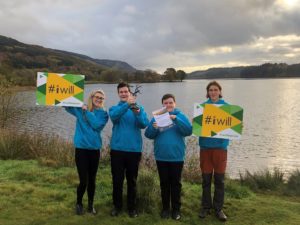
Loch Lomond Youth Committee receive the Best Engagement Project award at the UK National Parks Conference.
The road ahead
The Council of Europe will work with member states to implement these recommendations through its various programmes and initiatives. National governments are encouraged to develop specific action plans that reflect their unique context while adhering to the core principles outlined in the recommendations. Youth organisations, environmental NGOs, and other stakeholders are invited to participate in the implementation process and contribute to monitoring progress.
The adoption of these recommendations represent a significant step forward in recognising young people not just as victims of climate change but as crucial agents of change. It acknowledges their right to participate in decisions that will shape their future and provides a framework for ensuring their voices are heard. This is something EUROPARC is committed to promoting and implementing within the network, for example through the Youth Council.
These recommendations offer a roadmap for inclusive and intergenerational approaches to addressing one of the defining challenges of our time. EUROPARC is committed to promoting the implementation of these strategies at Protected Areas level, and promoting the work that is already being done which contributes to international goals and policies.
For more information, the full text of the recommendations can be accessed here.
How Can Protected Areas Become Hubs for Education for Sustainable Development
For the last year, the Alfred Toepfer Natural Heritage Scholarship supported the work of young conservationists in Protected Areas across Europe. Lucia Cușnir was one of the winners of the Scholarship in 2023 and travelled to Slovakia, Denmark, Hunary and within Romania to learn more about how Protected Areas can implement Education for Sustainable Development.
How Can Protected Areas Become Hubs for Education for Sustainable Development

Protected areas are no longer seen just as conservation zones to protect our natural and cultural heritage — they are increasingly being recognized as dynamic learning classrooms for people of all ages. These landscapes provide powerful opportunities for education, offering immersive, hands-on experiences that connect individuals with nature, culture, and sustainability in meaningful ways.
Education for Sustainable Development (ESD) in protected areas serves as a bridge between conservation efforts and community engagement, ensuring that people not only understand but actively participate in protecting our natural and cultural heritage.
Learning from the Field
This study tries to explore best practices, challenges, and opportunities in implementing ESD initiatives & activities across European protected areas, drawing insights from study visits to Tatra National Park (Slovakia), Lille Vildmose Centre (Denmark), Hortobágy National Park (Hungary), and the Danube Delta Biosphere Reserve (Romania).
Through qualitative research methods, including field observations, stakeholder interviews, and participatory engagement, the study highlights the diverse ways in which protected areas integrate ESD initiatives and activities into their management. Interpretive visitor centers, educational and interpretive trails, guided tours, Junior Ranger programmes, and hands-on conservation activities serve as key tools in fostering environmental awareness and responsibility. Additionally, local engagement through festivals, volunteering initiatives, and citizen science programs reinforces the role of communities in ESD.
Protected areas that prioritize community voices, cultural relevance, and local ownership are more likely to foster long-term conservation engagement.
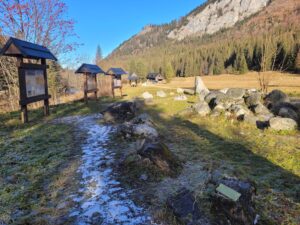
Tatra National Park, Slovakia, photo by Lucia Cușnir
Challenges and Opportunities in ESD
Despite strong local leadership and inspiring examples, many protected areas struggle with the same challenges: underfunding, staff shortages, and rigid policies that don’t reflect field realities. Rangers and educators often work beyond their mandates, driven by passion but lacking support.
However, there are also opportunities. Cross-sectoral partnerships with other protected areas, NGOs, educational institutions, and local authorities can enhance the reach and impact of ESD efforts. By sharing resources, and learning from each other’s experiences, these collaborations can create more resilient and innovative education programs.
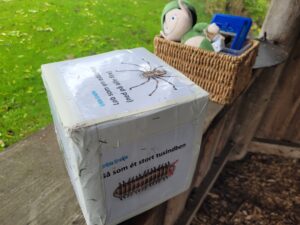
Lille Vildmose Centre, Denmark, photo by Lucia Cușnir
The Way Forward
For ESD to truly thrive in protected areas, it must be supported by policies that reflect real field experiences, and designed with flexibility in mind. Protected areas must also recognize that every ranger on patrol, every school visit, and every community gathering is a moment of education — and an opportunity for stewardship.
As this study shows, education doesn’t just happen through formal strategies. It lives in stories, gestures, trails, shared meals, and simple conversations on the field. ESD isn’t just about delivering information — it’s about sparking curiosity, sharing stories, and leading by example. When people meet the passionate educators and rangers behind conservation, they don’t just learn — they care.
Dive deeper into this topic through the report below!
Read the full report here!